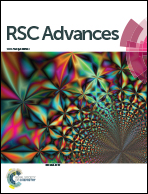Porous ZnO and ZnO–NiO composite nano/microspheres: synthesis, catalytic and biosensor properties†
Abstract
Porous ZnO and ZnO–NiO composite nano/microspheres have been successfully synthesized by the calcination of non-doped and Ni(II)-doped precursors in air, respectively. The catalytic effect was investigated for porous ZnO and ZnO–NiO composite nano/microspheres for the thermal decomposition of ammonium perchlorate (AP). The ZnO–NiO composite nano/microspheres showed remarkable catalytic effect for the thermal decomposition of AP. The decomposition temperature was decreased by 144.5 °C, and the apparent activation energy was significantly decreased to 117.8 kJ mol−1, which is considerably lower than 159.7 kJ mol−1 for pure AP. The catalytic capacity of ZnO–NiO composite nanostructures is higher than that of most of the materials reported to date. As a result, porous ZnO–NiO composite nano/microstructures could be a promising candidate material for an AP-based propellant. In addition, using the as-prepared porous ZnO microspheres, we have successfully prepared a novel, ultrahigh resolution electrochemical impedance DNA biosensor for the enhanced detection of the PML/RARA fusion gene in acute promyelocytic leukemia with a detection limit of 2.2 × 10−13 mol L−1; therefore, it can act as a biosensing materials for the recognition of DNA hybridization.


 Please wait while we load your content...
Please wait while we load your content...